
Alien Coitus
Clinging to the stem of a goldenrod plant, these two ambush bugs make such an adorable couple! True to their name, these strange insects wait, often hidden amidst flowers, for a tiny, hapless bee or butterfly. Photo taken in Bald Eagle State Forest, PA, USA. Prints of this image are not currently available for sale. Please check back for future availability!
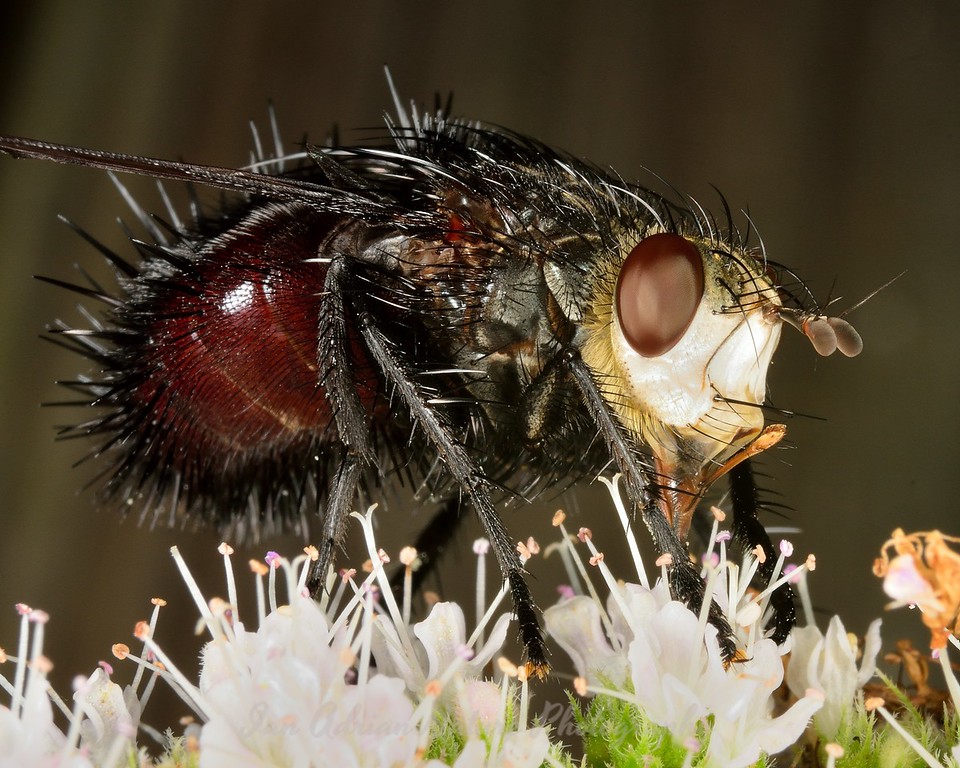
Tachinid Fly
Although they do their share of pollinating and even look cute from the right angle (please note: this is not the right angle), Tachinid Flies are parasitic to a plethora of other insect species. They will lay eggs inside the unfortunate host. These eggs will hatch into ravenous larva that begin eating the poor thing, from the inside. Photo taken in Winfield, PA, USA.
Purchase This Print
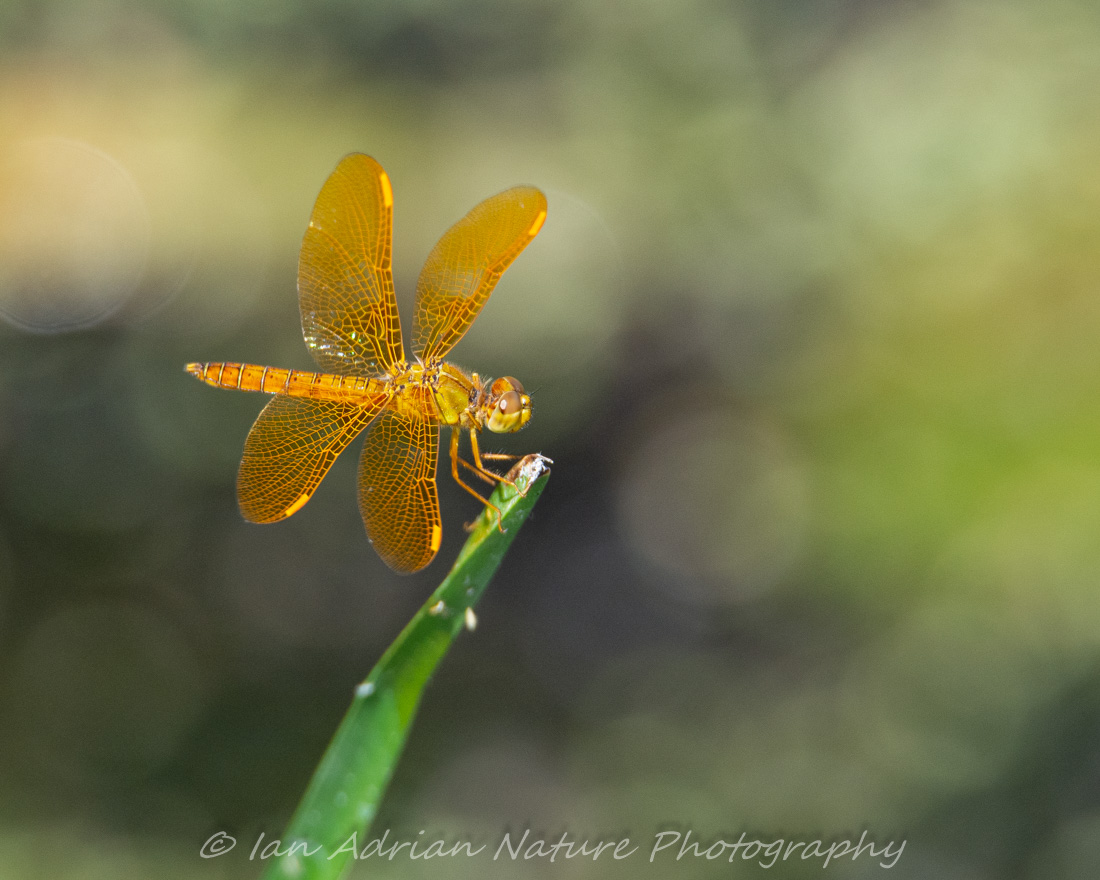
Yellow Dragon
This yellow dragonfly is one of the most striking I have yet to see. Tucson, AZ.
Purchase This Print

Dinosaur Hopper
In addition to "great crested," this large grasshopper is commonly known as the "dinosaur grasshopper." I can see the likeness. Following this encounter, my companion looked up their common names and was ecstatic to share that "dinosaur" was one.
SE Arizona.
Purchase This Print
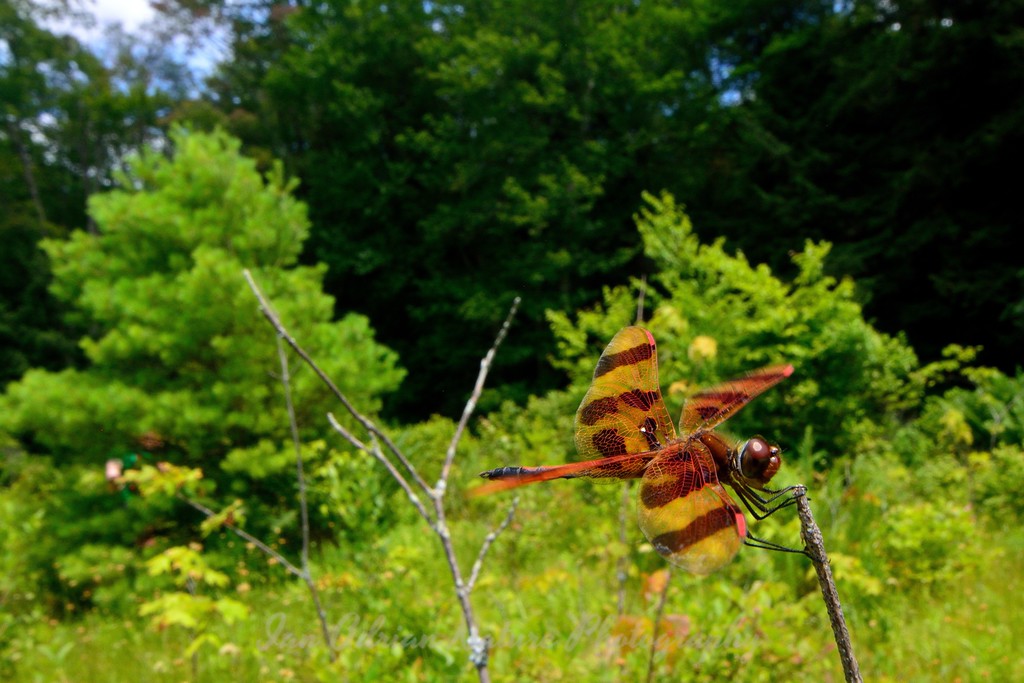
Halloween Pennant
A Halloween pennant dragonfly, surrounded by it's natural environment. Photographed in Loyalsock State Forest, PA, USA.
Purchase This Print
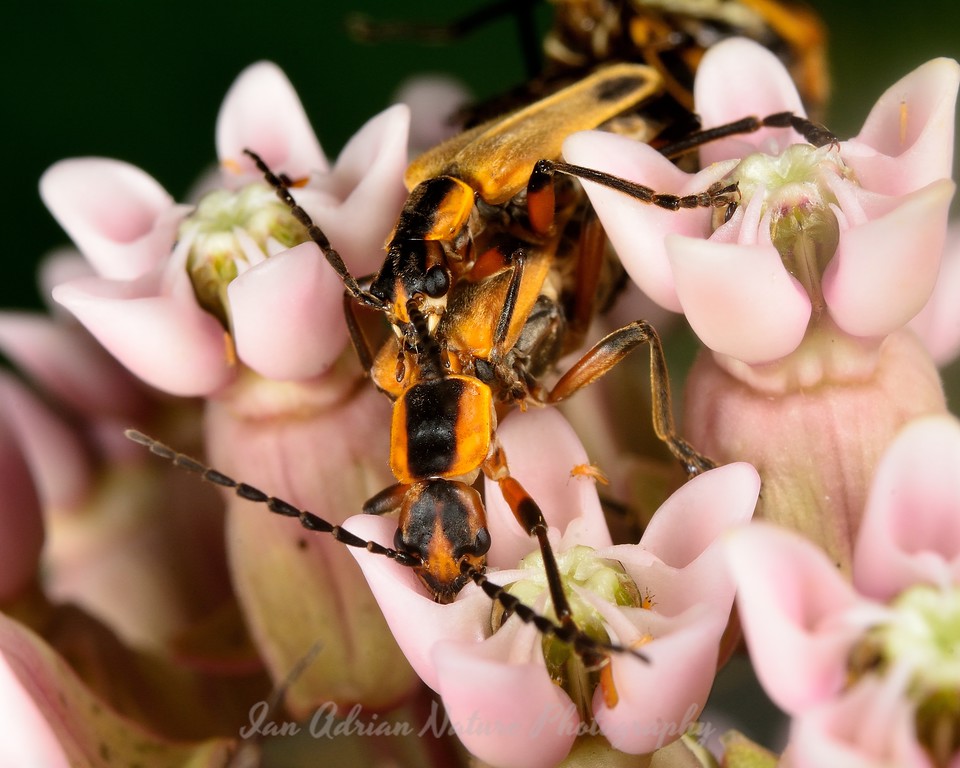
Milkweed Bugs
A pair of milkweed bugs (not to be confused with milkweed beetles), caught in mid-coitus, atop the flowers of a Common Milkweed. Photo taken in Winfield, PA, USA.
Purchase This Print

Grasshopper and the Robber
A robber fly captures and kills smaller insects. Incidentally, this grasshopper was a bit too large and had to be abandoned. Mt Lemmon, AZ.
Purchase This Print
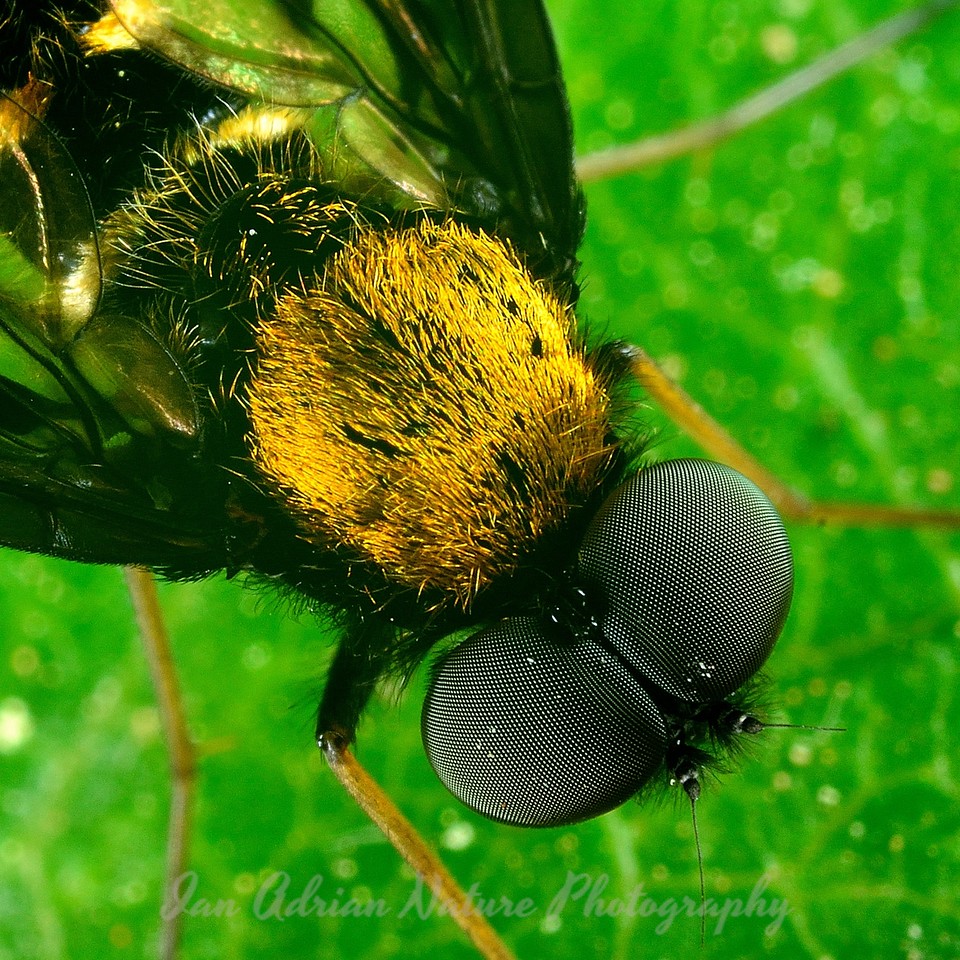
A Fly’s Eyes
When zooming in extremely close to an insect’s face, one can see the kaleidoscope of panels that make up it’s compound eyes. This wonderful subject is gold-backed snipe fly. Photo taken near Danville, PA, USA.
Purchase This Print
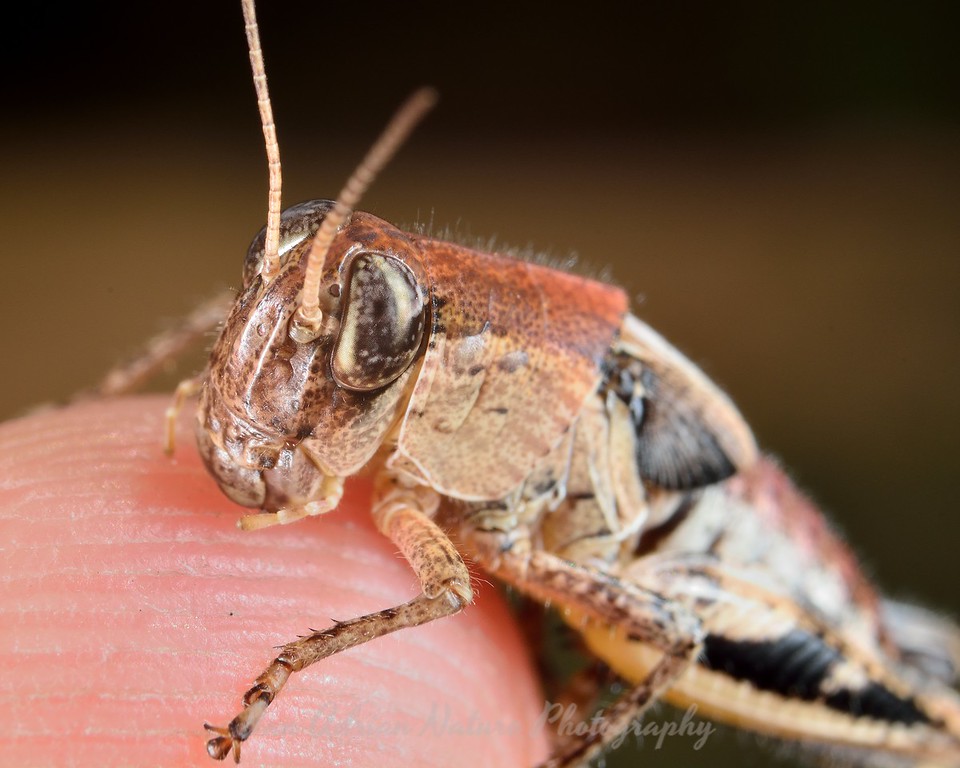
Hungy Hopper
On rare occasion, a photographer must quite literally put their flesh/blood into the efforts of a picture. This grasshopper was proving itself to be a challenging photography subject, until I had the thought to stage some shots from the end of my finger. My subject was quite content to rest here, and after a few seconds, I knew why when a sharp pain visited my fingertip. I let him/her continue to munch, snapping my shots one-handed. Photo taken in Bald Eagle State Forest, PA, USA.
Purchase This Print

Ambush Bug
This unusual insect is a common, yet rarely-seen inhabitant of American gardens. Ambush bugs are tiny predators that, true to their name, sit atop flowers, awaiting tiny flying insects. Photo taken in Winfield, PA, USA.
Purchase This Print
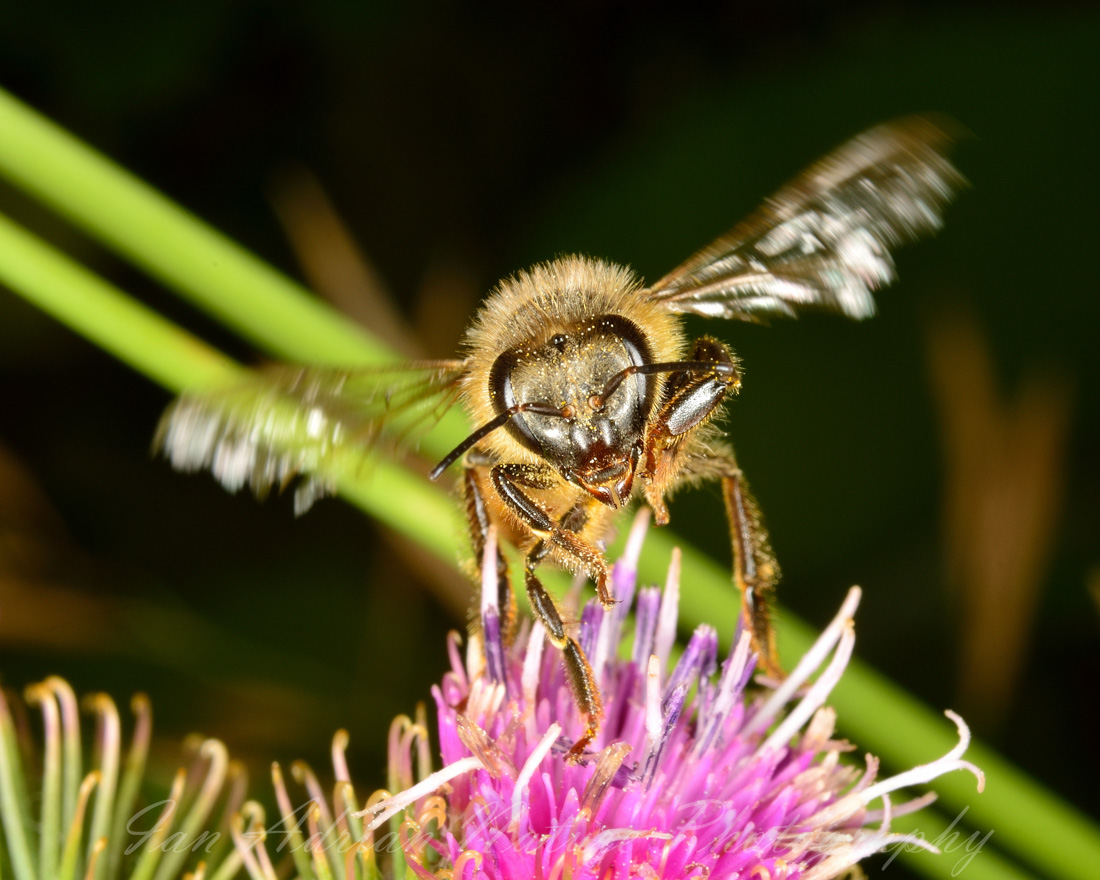
Bee Take-Off
Having finished his/her thistle flower pit stop, this busy honeybee takes off for the next blossom. Bees can be kind of scary, but without them, we would have almost no food. We need to better protect our pollinators! The toxic outdoor chemicals we use (insecticides, roundup, etc) just cause instant death to our tiny friends, and slow, cancerous deaths to us. Please just stop using any type of outdoor chemical that ends in "cide." Photo taken near Hartleton, PA, USA.
Purchase This Print
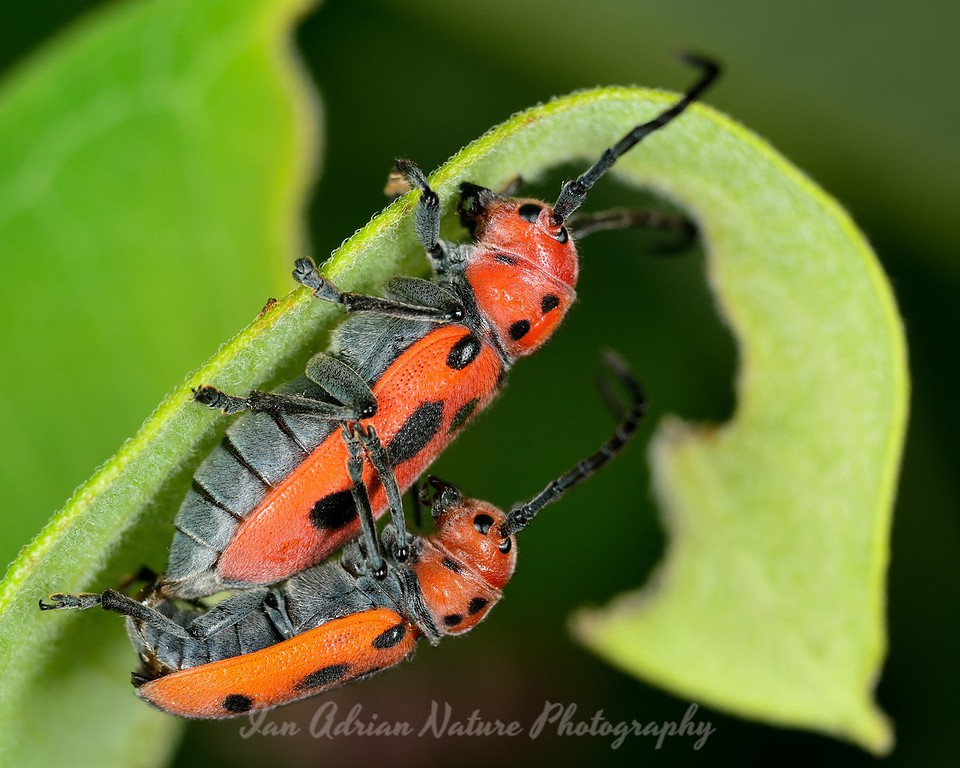
Milkweed Beetles
A lovely pair of red milkweed beetles perched on a well-chewed common milkweed leaf. Milkweed is a necessary host plant for the threatened monarch butterfly.
Not only does this plant's flower provide food for a number of other pollinators, but it also allows funky critters like these to live their lives. Please consider planting milkweed in your yard! Photo taken in Selinsgrove, PA.
Purchase This Print
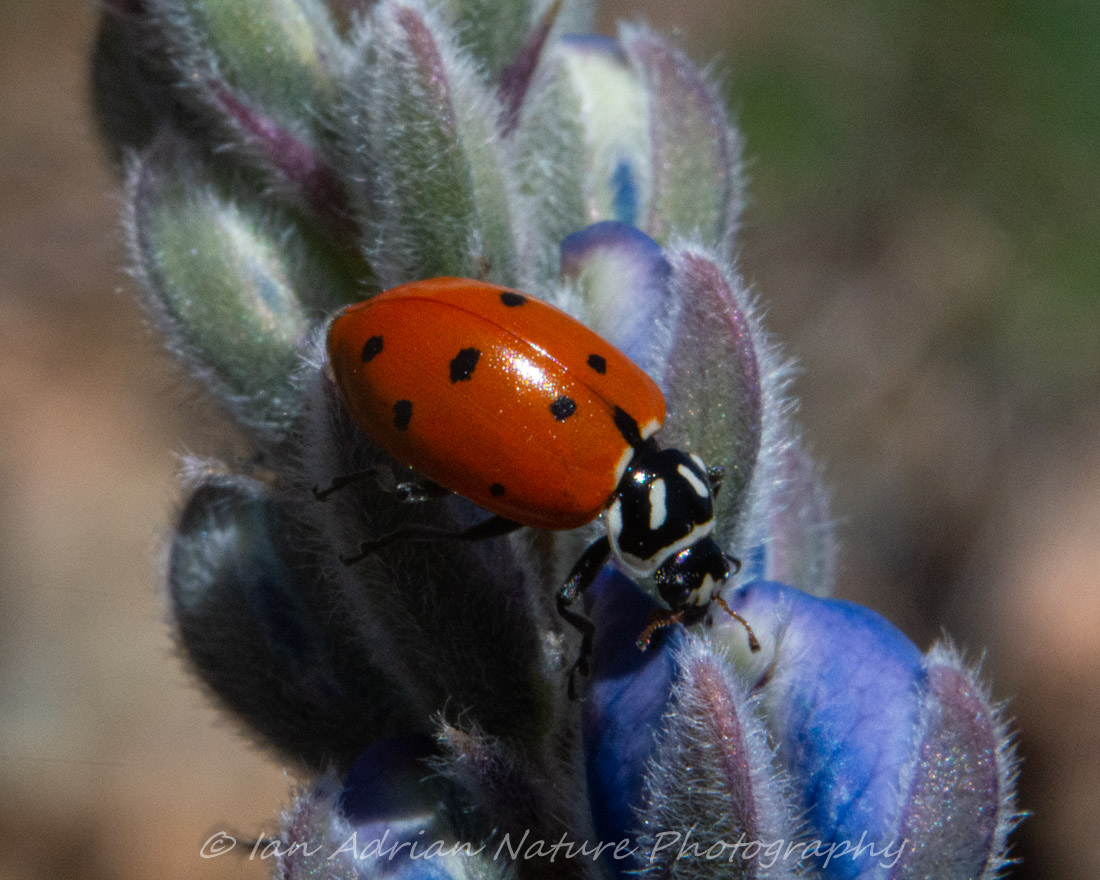
Lovely Ladybug
A little, tiny ladybug scaling some large, luscious, lupine wildflowers. Butterfly Peak Natural Area, AZ.
Purchase This Print
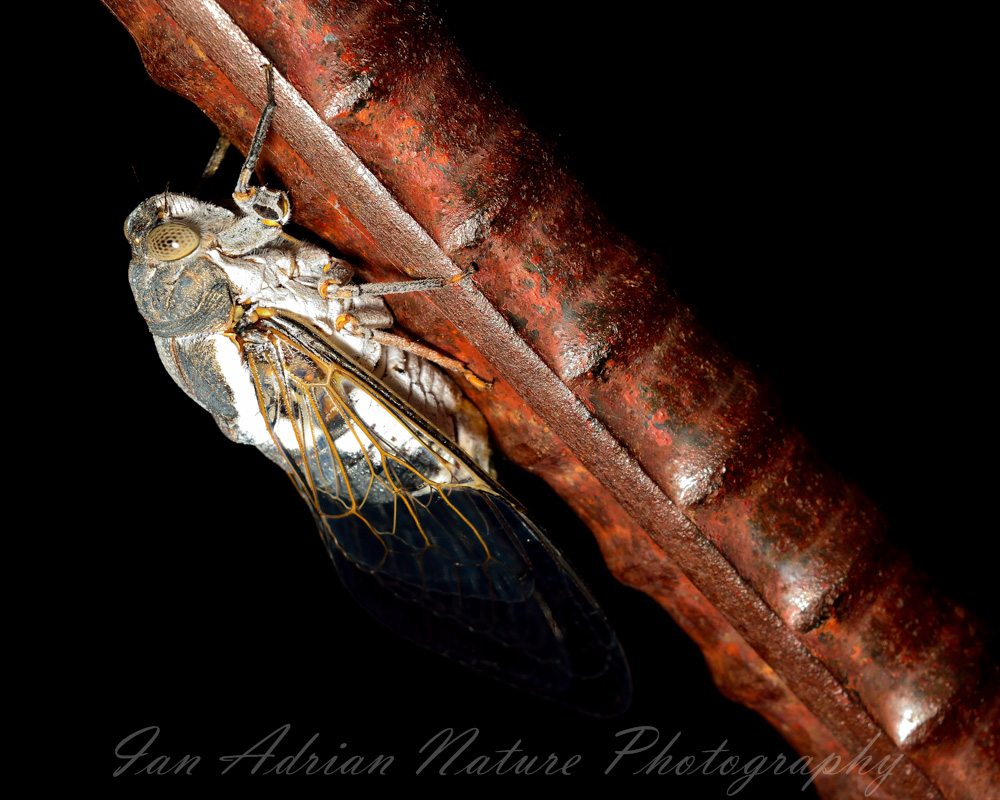
Western Cicada
Although short-lived, a mass cicada emergence spells a feast for any number of birds and reptiles in the Sonoran Desert.
Cicadas have an unusual generational cycle. Some species emerge every few years, and some wait underground for 17 years before emerging en-masse, then dying shortly after. This Western Cicada was hanging on a gate at the end of my backyard hiking trail.
Purchase This Print

Blister Beetle Wings
Despite their potential to secrete a nasty irritant, blister beetles tend to be quite lovely. Southeast Arizona.
Purchase This Print

Blister Beetle
Despite their potential to secrete a nasty irritant, blister beetles tend to be quite lovely. Southeast Arizona.
Purchase This Print
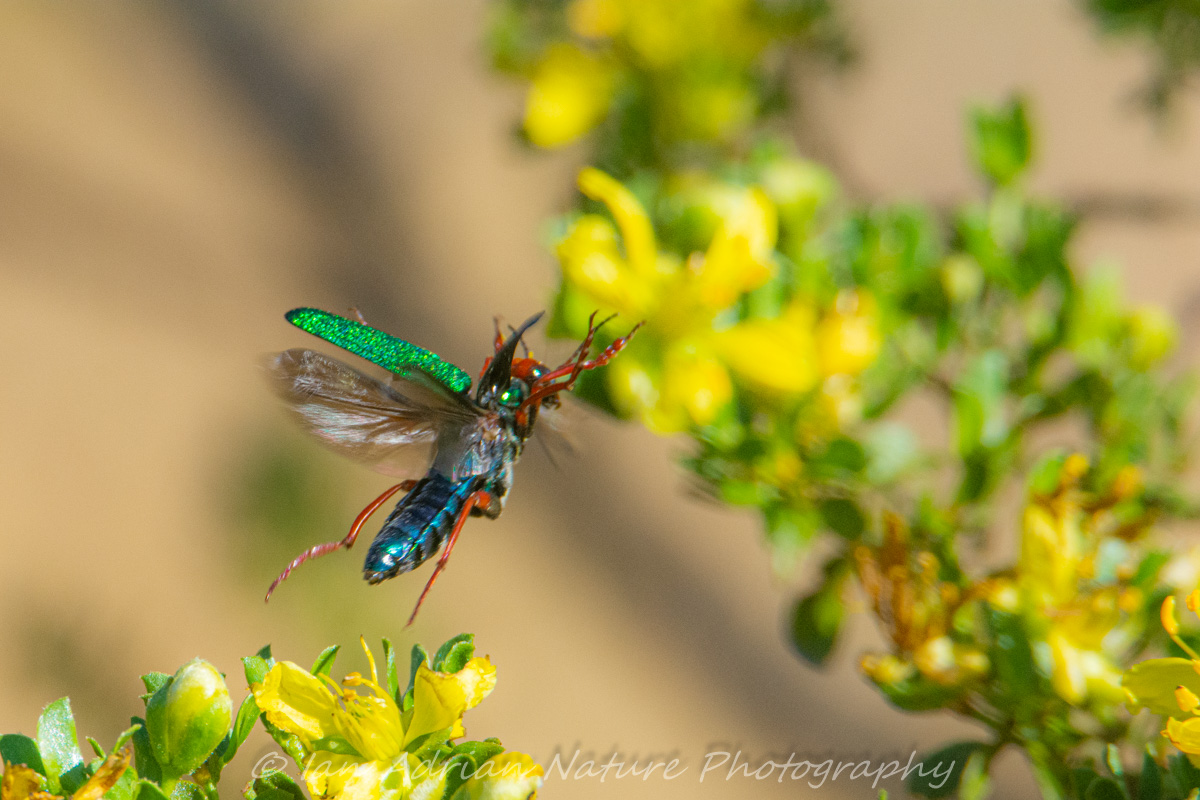
Blister Beetle Take-off
Despite their potential to secrete a nasty irritant, blister beetles tend to be quite lovely. Southeast Arizona.
Purchase This Print
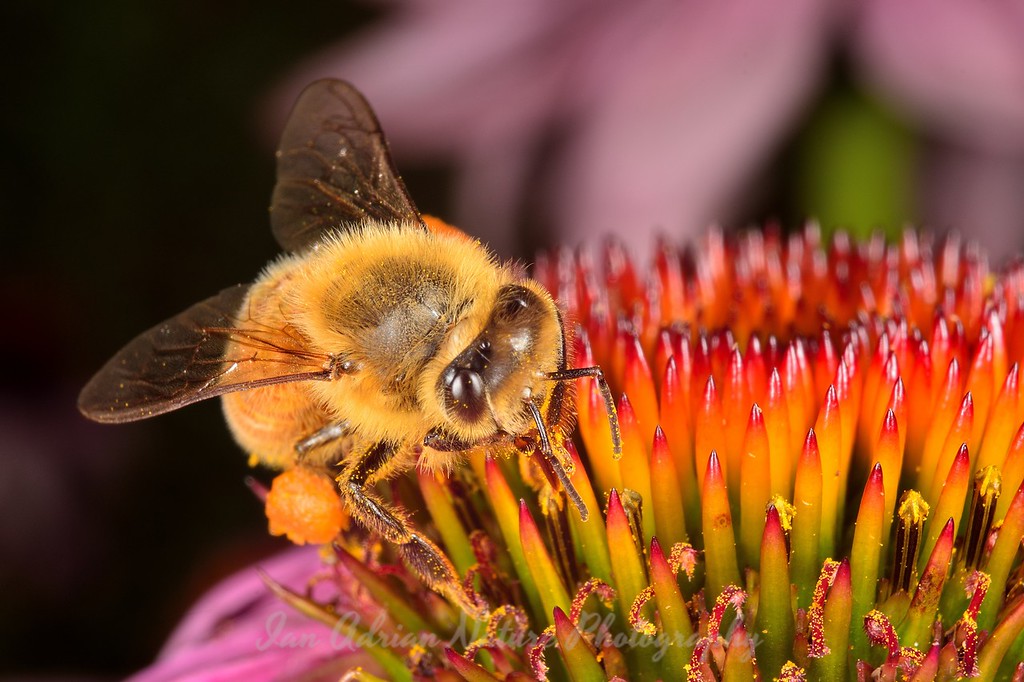
Honey Bee and the Coneflower
When closely inspecting a purple coneflower (echinacea), the plant has a very alien appearance. This wild honeybee no doubt had quite a plunder at this enormous flower! Bees can be kind of scary, but without them, we would have almost no food. We need to better protect our pollinators! The toxic outdoor chemicals we use (insecticides, roundup, etc) just cause instant death to our tiny friends, and slow, cancerous deaths to us. Please just stop using any type of outdoor chemical that ends in "cide." Photo taken near Hartleton, PA, USA. Prints of this image are currently unavailable for sale. Please check back for availability.
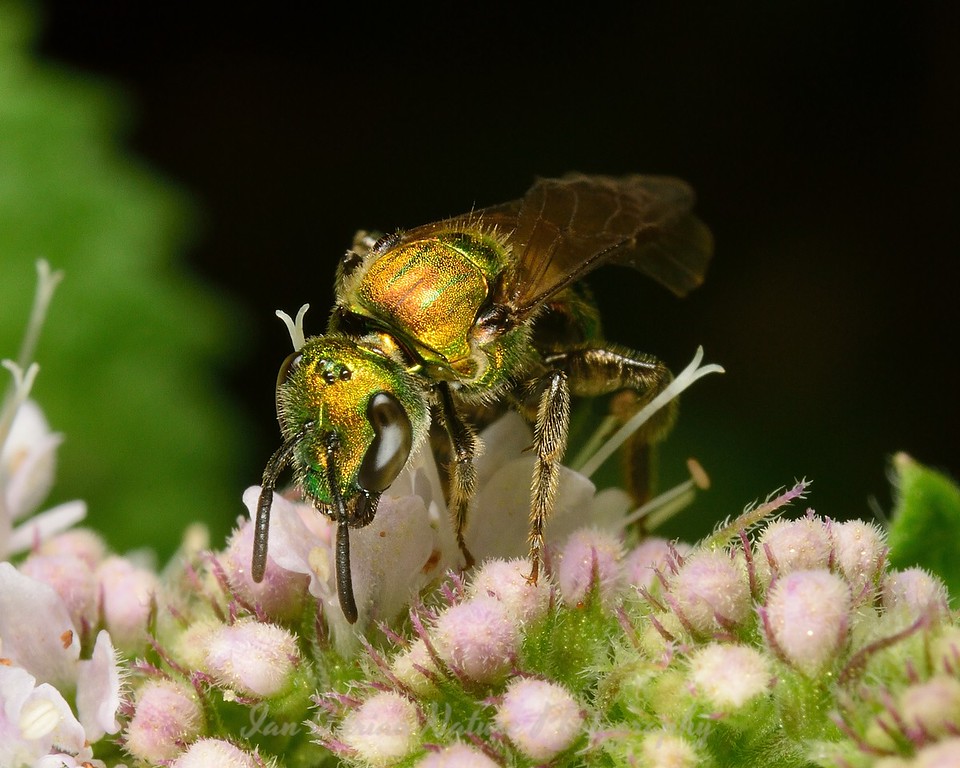
Metallic Sweat Bee
These tiny, beautiful sweat bees go by many names, “Green Metallic” being one. Extremely effective pollinators, these insects collect both pollen and nectar to feed their young. Like other bees, they are essential to the pollination of many plants, some of which we count on for food.
Please abandon the use of roundup, or any other outdoor chemical ending in "cide." Many of these toxic products kill bees, and give us cancer. Shown on mint flowers. Photo taken in Winfield, PA, USA.
Purchase This Print
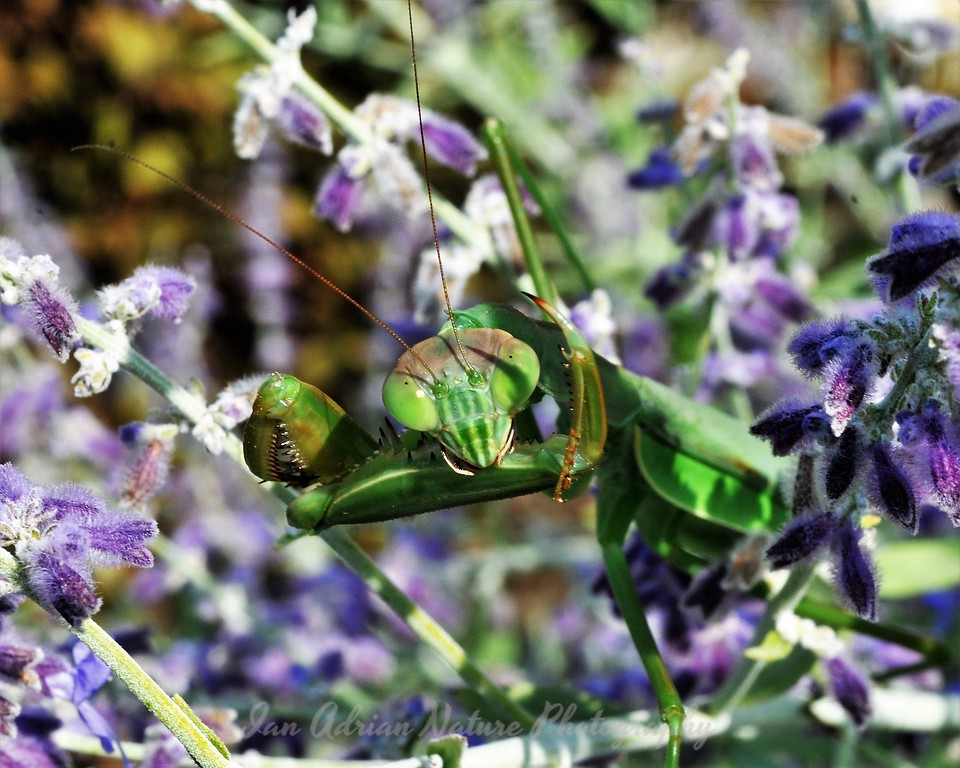
Alien Encounter
It wasn't the X-files that convinced me aliens exist....it was this Chinese Praying Mantis. She's in the process of cleaning her pedipalps (claws), while perched on flowering Russian Sage. Chinese mantises have largely come to replace the native Carolina mantis that once inhabited much of the US. These powerful insects sometimes catch and kill small birds, such as our beautiful hummingbirds.
Garden and farm tenders, should you need to introduce natural insect control, please specifically choose the Carolina species, instead.
Photographed near Selinsgrove, PA, USA.
Purchase This Print

Dreamy Eyes
A Chinese Praying Mantis, possibly day-dreaming about what it's like to be a butterfly or some other creature? Who's to say?
Chinese mantises have largely come to replace the native Carolina mantis that once inhabited much of the US. These powerful insects sometimes catch and kill small birds, such as our beautiful hummingbirds.
Garden and farm tenders, should you need to introduce natural insect control, please specifically choose the Carolina species, instead. Photographed in Sunbury, PA, USA.
Purchase This Print

Alien Coitus
Clinging to the stem of a goldenrod plant, these two ambush bugs make such an adorable couple! True to their name, these strange insects wait, often hidden amidst flowers, for a tiny, hapless bee or butterfly. Photo taken in Bald Eagle State Forest, PA, USA. Prints of this image are not currently available for sale. Please check back for future availability!

Tachinid Fly
Although they do their share of pollinating and even look cute from the right angle (please note: this is not the right angle), Tachinid Flies are parasitic to a plethora of other insect species. They will lay eggs inside the unfortunate host. These eggs will hatch into ravenous larva that begin eating the poor thing, from the inside. Photo taken in Winfield, PA, USA.
Purchase This Print

Yellow Dragon
This yellow dragonfly is one of the most striking I have yet to see. Tucson, AZ.
Purchase This Print

Dinosaur Hopper
In addition to "great crested," this large grasshopper is commonly known as the "dinosaur grasshopper." I can see the likeness. Following this encounter, my companion looked up their common names and was ecstatic to share that "dinosaur" was one.
SE Arizona.
Purchase This Print

Halloween Pennant
A Halloween pennant dragonfly, surrounded by it's natural environment. Photographed in Loyalsock State Forest, PA, USA.
Purchase This Print

Milkweed Bugs
A pair of milkweed bugs (not to be confused with milkweed beetles), caught in mid-coitus, atop the flowers of a Common Milkweed. Photo taken in Winfield, PA, USA.
Purchase This Print

Grasshopper and the Robber
A robber fly captures and kills smaller insects. Incidentally, this grasshopper was a bit too large and had to be abandoned. Mt Lemmon, AZ.
Purchase This Print

A Fly’s Eyes
When zooming in extremely close to an insect’s face, one can see the kaleidoscope of panels that make up it’s compound eyes. This wonderful subject is gold-backed snipe fly. Photo taken near Danville, PA, USA.
Purchase This Print

Hungy Hopper
On rare occasion, a photographer must quite literally put their flesh/blood into the efforts of a picture. This grasshopper was proving itself to be a challenging photography subject, until I had the thought to stage some shots from the end of my finger. My subject was quite content to rest here, and after a few seconds, I knew why when a sharp pain visited my fingertip. I let him/her continue to munch, snapping my shots one-handed. Photo taken in Bald Eagle State Forest, PA, USA.
Purchase This Print

Ambush Bug
This unusual insect is a common, yet rarely-seen inhabitant of American gardens. Ambush bugs are tiny predators that, true to their name, sit atop flowers, awaiting tiny flying insects. Photo taken in Winfield, PA, USA.
Purchase This Print

Bee Take-Off
Having finished his/her thistle flower pit stop, this busy honeybee takes off for the next blossom. Bees can be kind of scary, but without them, we would have almost no food. We need to better protect our pollinators! The toxic outdoor chemicals we use (insecticides, roundup, etc) just cause instant death to our tiny friends, and slow, cancerous deaths to us. Please just stop using any type of outdoor chemical that ends in "cide." Photo taken near Hartleton, PA, USA.
Purchase This Print

Milkweed Beetles
A lovely pair of red milkweed beetles perched on a well-chewed common milkweed leaf. Milkweed is a necessary host plant for the threatened monarch butterfly.
Not only does this plant's flower provide food for a number of other pollinators, but it also allows funky critters like these to live their lives. Please consider planting milkweed in your yard! Photo taken in Selinsgrove, PA.
Purchase This Print

Lovely Ladybug
A little, tiny ladybug scaling some large, luscious, lupine wildflowers. Butterfly Peak Natural Area, AZ.
Purchase This Print

Western Cicada
Although short-lived, a mass cicada emergence spells a feast for any number of birds and reptiles in the Sonoran Desert.
Cicadas have an unusual generational cycle. Some species emerge every few years, and some wait underground for 17 years before emerging en-masse, then dying shortly after. This Western Cicada was hanging on a gate at the end of my backyard hiking trail.
Purchase This Print

Blister Beetle Wings
Despite their potential to secrete a nasty irritant, blister beetles tend to be quite lovely. Southeast Arizona.
Purchase This Print

Blister Beetle
Despite their potential to secrete a nasty irritant, blister beetles tend to be quite lovely. Southeast Arizona.
Purchase This Print

Blister Beetle Take-off
Despite their potential to secrete a nasty irritant, blister beetles tend to be quite lovely. Southeast Arizona.
Purchase This Print

Honey Bee and the Coneflower
When closely inspecting a purple coneflower (echinacea), the plant has a very alien appearance. This wild honeybee no doubt had quite a plunder at this enormous flower! Bees can be kind of scary, but without them, we would have almost no food. We need to better protect our pollinators! The toxic outdoor chemicals we use (insecticides, roundup, etc) just cause instant death to our tiny friends, and slow, cancerous deaths to us. Please just stop using any type of outdoor chemical that ends in "cide." Photo taken near Hartleton, PA, USA. Prints of this image are currently unavailable for sale. Please check back for availability.

Metallic Sweat Bee
These tiny, beautiful sweat bees go by many names, “Green Metallic” being one. Extremely effective pollinators, these insects collect both pollen and nectar to feed their young. Like other bees, they are essential to the pollination of many plants, some of which we count on for food.
Please abandon the use of roundup, or any other outdoor chemical ending in "cide." Many of these toxic products kill bees, and give us cancer. Shown on mint flowers. Photo taken in Winfield, PA, USA.
Purchase This Print

Alien Encounter
It wasn't the X-files that convinced me aliens exist....it was this Chinese Praying Mantis. She's in the process of cleaning her pedipalps (claws), while perched on flowering Russian Sage. Chinese mantises have largely come to replace the native Carolina mantis that once inhabited much of the US. These powerful insects sometimes catch and kill small birds, such as our beautiful hummingbirds.
Garden and farm tenders, should you need to introduce natural insect control, please specifically choose the Carolina species, instead.
Photographed near Selinsgrove, PA, USA.
Purchase This Print

Dreamy Eyes
A Chinese Praying Mantis, possibly day-dreaming about what it's like to be a butterfly or some other creature? Who's to say?
Chinese mantises have largely come to replace the native Carolina mantis that once inhabited much of the US. These powerful insects sometimes catch and kill small birds, such as our beautiful hummingbirds.
Garden and farm tenders, should you need to introduce natural insect control, please specifically choose the Carolina species, instead. Photographed in Sunbury, PA, USA.
Purchase This Print

Alien Coitus
Clinging to the stem of a goldenrod plant, these two ambush bugs make such an adorable couple! True to their name, these strange insects wait, often hidden amidst flowers, for a tiny, hapless bee or butterfly. Photo taken in Bald Eagle State Forest, PA, USA. Prints of this image are not currently available for sale. Please check back for future availability!
As far as wildlife goes, insects are surely the backbone of the natural world. They provide the majority of plant pollination that occurs, they are the main source of food for an untold number of birds, mammals, reptiles, amphibians, and arachnids. Insects help to decompose waste materials. They fly, crawl, and swim. There are estimated to be more than 30 million different insect species, and most of them have never even been described (identified as a new species). Insects can be found on every continent, and in nearly any habitat on the planet, and our understanding of these incredible little creatures is only in it’s infancy. This album is mostly characterized by macro pictures of these beautiful creatures which are all around us (yet rarely observed) in day-to-day life.
